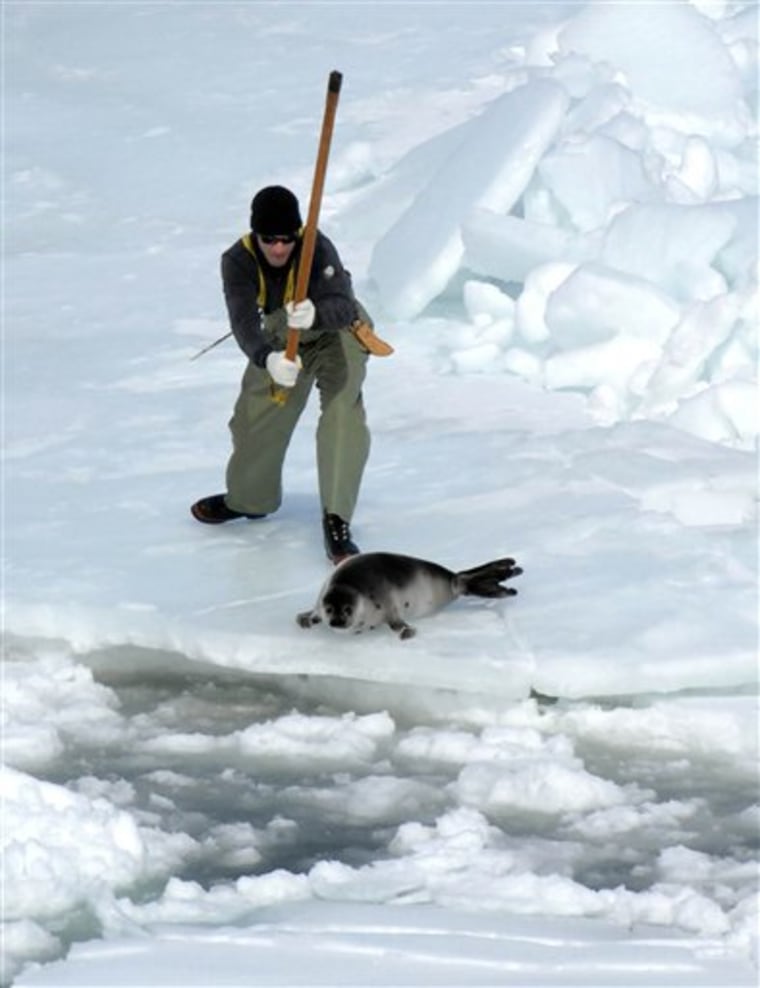A disabled fishing trawler getting a tow from a Canadian coast guard vessel slammed into a piece of ice and capsized Saturday in the icy waters of the Gulf of St. Lawrence, killing three seal hunters and leaving one missing.
The vessel was headed toward a large seal herd in the Cabot Strait between Nova Scotia and Newfoundland as part of the seal hunt season that opened Friday, the largest marine mammal hunt in the world.
The tragedy came as the seal hunting industry finds itself under pressure from animals rights activists. Activists from the Humane Society of the United States and the International Fund for Animal Welfare were using helicopters to monitor the hunt's opening day.
Hunters are allowed to take up to 275,000 animals this season.
Sealers and the fisheries department defend the hunt as sustainable, humane and well-managed, and say it provides supplemental income for isolated fishing communities that have been hurt by the decline in cod stocks.
'It was dark'
The 40-foot fishing boat from Iles-de-la-Madeleine in Quebec, carrying a crew of six, had reported steering problems late Friday north of Cape Breton, Nova Scotia, when the coast guard ship took it in tow.
Bruno-Pierre Bourque, whose father died in Saturday's accident but who survived it himself, said a combination of speed and inattention by the coast guard crew caused the fishing boat to flip over.
Bourque said he was at the helm of the rudderless trawler when the light Canadian Coast Guard icebreaker giving them a tow sped up.
"It all happened very vast, it was dark," Bourque told Radio-Canada's all-news channel RDI.
"A big piece of ice was suddenly in front of us, we couldn't avoid it. We tried what we could but without a rudder there wasn't much we could do."
Investigation begins
Federal officials holding a news conference Saturday in Dartmouth, Nova Scotia, said they couldn't comment on the speed of the vessel.
Mike Voigt, the Canadian Coast Guard's superintendent of search and rescue, said the towing procedure was common and it was up to the crew of the disabled vessel to determine whether they should stay aboard.
Canada's Transportation Safety Board is investigating.
Iles-de-la-Madeleine Mayor Joel Arseneau identified the dead as Bruno Bourque, the boat's owner and captain; Gilles Leblanc, a hunter in his 50s; and Marc-Andre Deraspe, a hunter in his early 20s. The missing hunter was identified as Carl Aucoin.
"We're certainly in a state of shock here on the islands," Arseneau said Saturday of the tightly knit community of about 13,000 on Iles-de-la-Madeleine, a dozen islands about 50 miles north of Prince Edward Island's eastern tip.
Under pressure from animal rights activists, hunters this year will take extra steps to make sure the seals are dead before skinning them by severing the arteries under a seal's flippers — a recommendation made in a European Union report released in December.
Fishermen sell seal pelts mostly to the fashion industry in Norway, Russia and China, as well as blubber for oil, earning about $78 for each seal. The 2006 hunt brought in about $25 million.
The United States has banned Canadian seal products since 1972.
